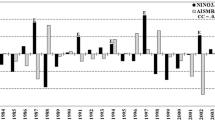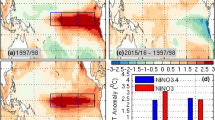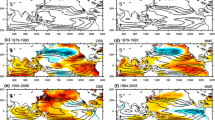Abstract
Long-lead prediction of waxing and waning of the Western North Pacific (WNP)-East Asian (EA) summer monsoon (WNP-EASM) precipitation is a major challenge in seasonal time-scale climate prediction. In this study, deficiencies and potential for predicting the WNP-EASM precipitation and circulation one or two seasons ahead were examined using retrospective forecast data for the 26-year period of 1981–2006 from two operational couple models which are the National Centers for Environmental Prediction (NCEP) Climate Forecast System (CFS) and the Bureau of Meteorology Research Center (BMRC) Predictive Ocean–Atmosphere Model for Australia (POAMA). While both coupled models have difficulty in predicting summer mean precipitation anomalies over the region of interest, even for a 0-month lead forecast, they are capable of predicting zonal wind anomalies at 850 hPa several months ahead and, consequently, satisfactorily predict summer monsoon circulation indices for the EA region (EASMI) and for the WNP region (WNPSMI). It should be noted that the two models’ multi-model ensemble (MME) reaches 0.40 of the correlation skill for the EASMI with a January initial condition and 0.75 for the WNPSMI with a February initial condition. Further analysis indicates that prediction reliability of the EASMI is related not only to the preceding El Niño and Southern Oscillation (ENSO) but also to simultaneous local SST variability. On other hand, better prediction of the WNPSMI is accompanied by a more realistic simulation of lead–lag relationship between the index and ENSO. It should also be noted that current coupled models have difficulty in capturing the interannual variability component of the WNP-EASM system which is not correlated with typical ENSO variability. To improve the long-lead seasonal prediction of the WNP-EASM precipitation, a statistical postprocessing was developed based on the multiple linear regression method. The method utilizes the MME prediction of the EASMI and WNPSMI as predictors. It is shown that the statistical postprocessing is able to improve forecast skill for the summer mean precipitation over most of the WNP-EASM region at all forecast leads. It is noteworthy that the MME prediction, after applying statistical postprocessing, shows the best anomaly pattern correlation skill for the EASM precipitation at a 4-month lead (February initial condition) and for the WNPSM precipitation at a 5-month lead (January initial condition), indicating its potential for improving long-lead prediction of the monsoon precipitation.













Similar content being viewed by others
References
Alexander MA, Deser C (1995) A mechanism for the recurrence of wintertime midlatitude SST anomalies. J Phys Oceanogr 25:122–137
Alexander MA, Deser C, Timlin MS (1999) The reemergence of SST anomalies in the North Pacific Ocean. J Climate 12:2419–2433
Alves O et al (2003) POAMA: Bureau of meteorology operational coupled model seasonal forecast system. In: Proceedings of national drought forum, Brisbane, April 2003, pp 49–56
Ashok K, Behera S, Rao AS, Weng HY, Yamagata T (2007) El Nino Modoki and its possible teleconnection. J Geophys Res 112:C11007. doi:10.1029/2006JC003798
Feddersen H, Navarra A, Ward MN (1999) Reduction of model systematic error by statistical correction for dynamical seasonal prediction. J Climate 12:1974–1989
Gadjil S, Sajani S (1998) Monsoon precipitation in the AMIP runs. Clim Dyn 14:659–689
Ha KJ, Park SK, Kim KY (2005) On interannual characteristics of climate prediction center merged analysis precipitation over the Korean Peninsula during the summer monsoon season. Int J Climatol 25:99–116
Huang G (2003) An index measuring the interannual variation of the East Asian summer monsoon-the EAP index. Adv Atmos Sci 21:41–52
Huang A, Zhang Y, Gao X (2007) Impacts of coastal SST variability on the East Asian summer monsoon. Adv Atmos Sci 24:259–270
Kalnay E, Coauthors (1996) The NCEP/NCAR 40-year reanalysis project. Bull Am Meteor Soc 77:437–471
Kang IS et al (2002) Intercomparison of the climatological variations of Asian summer monsoon precipitation simulated by 10 GCMs. Clim Dyn 19:383–395
Kang IS, Shukla J (2006) Dynamic seasonal prediction and predictability (Chap. 15). The Asian Monsoon, Springer Praxis, Chicherster, pp 585–612
Kang IS, Lee JY, Park CK (2004) Potential predictability of summer mean precipitation in a dynamical seasonal prediction system with systematic error correction. J Clim 17:834–844
Koster RD, Suarez MJ (2003) Impact of land surface initialization on seasonal precipitation and temperature prediction. J Hydrometeor 4:408–423
Kumar A, Hoerling MP (1995) Prospects and limitations of atmospheric GCM climate predictions. Bull Am Meteorol Soc 76:335–345
Kumar A, Jha B, Zhang Q, Bounoua L (2007) Methodology for estimating the unpredictable component of seasonal atmospheric variability. J Climate 20:3888–3901
Lau KM, Kim KM, Yang S (2000) Dynamical and boundary forcing characteristics of regional components of the Asian summer monsoon. J Clim 13:2461–2482
Lee JY, Wang B, Kang IS, Shukla J et al (2010) How are seasonal prediction skills related to models’ performance on mean state and annual cycle? Clim Dyn. doi:10.1007/s00382-010-0857-4
Liang J, Yang S, Hu ZZ, Huang B, Kumar A, Zhang Z (2009) Predictable patterns of the Asian and Indo-Pacific summer precipitation in the NCEP CFS. Clim Dyn 32:989–1001
Moorthi S, Pan HL, Caplan P (2001) Changes to the 2001 NCEP operational MRF/AVN global analysis/forecast system. NWS Tech. 484. Available online at http://www.nws.noaa.gov/om/tpb/484.htm
Pacanowski RC, Griffies SM (1998) MOM 3.0 manual. NOAA/GFDL. Available online at http://www.gfdl.noaa.gov/~smg/MOM/web/guide_parent/guide_parent.html
Rayner NA, Parker DE, Horton EB, Folland CK, Alexander LV, Rowell DP (2003) Global analyses of SST, sea ice, and night marine air temperature since the late nineteenth century. J Geophys Res 108:4407. doi:10.1029/2002JD002670
Rowell DP (1998) Assessing potential seasonal predictability with an ensemble of multidecadal GCM simulations. J Clim 11:109–120
Saha S et al (2006) The NCEP climate forecast system. J Clim 19:3483–3517
Sperber KR, Palmer TN (1996) Interannual tropical rainfall variability in general circulation model simulations associated with the Atmospheric Model Intercomparison Project. J Climate 9:2727–2750
Sperber KR, Slingo JM, Annamalai H (2000) Predictability and the relationship between subseasonal and interannual variability during the Asian summer monsoon. Q J R Meteorol Soc 126:2545–2574
Wang B, Fan Z (1999) Choice of South Asian summer monsoon indices. Bull Am Meteor Soc 80:629–638
Wang B, Wu R, Fu X (2000) Pacific-East Asian teleconnection: how does ENSO affect East Asian climate? J Clim 13:1517–1536
Wang B, Wu R, Lau KM (2001) Interannual variability of the Asian summer monsoon: Contrasts between the Indian and the western North Pacific-East Asian monsoons. J Clim 15:4073–4090
Wang B, Kang IS, Lee JY (2004) Ensemble simulations of Asian–Australian monsoon variability by 11 AGCMs. J Clim 17:803–818
Wang B, Lee JY, Kang IS, Shukla J, Hameed SN, Park CK (2007) Coupled predictability of seasonal tropical precipitation. CLIVAR Exchanges 12:17–18
Wang B, Lee JY, Kang IS, Shukla J et al (2008a) How accurately do coupled climate models predict the Asian–Australian monsoon interannual variability? Clim Dyn 30:605–619
Wang G, Alves O, Hudson D, Hendon H, Liu G, Tseitkin F (2008b) SST skill assessment from the new POAMA-1.5 system. BMRC Res Lett 8:2–6
Wang B, Lee JY, Kang IS, Shukla J et al (2009) Advance and prospectus of seasonal prediction: assessment of the APCC/CliPAS 14-model ensemble retrospective seasonal prediction (1980–2004). Clim Dyn 33:93–117
Webster PJ, Yang S (1992) Monsoon and ENSO: selectively interactive systems. Q J R Meteorol Soc 118:877–926
Weng H, Ashok K, Behera SK, Rao SA, Yamagata T (2007) Impacts of recent El Nino Modoki on dry/wet conditions in the Pacific rim during boreal summer. Clim Dyn 29:113–129
Xie P, Arkin P (1997) Global precipitation: a 17-year monthly analysis based on gauge observations, satellite estimates and numerical model outputs. Bull Am Meteor Soc 78:2539–2558
Yang S, Zhang Z, Kousky VE, Higgins RW, Yoo SH, Liang J, Fan Y (2008) Simulations and seasonal prediction of the Asian summer monsoon in the NCEP Climate Forecast System. J Climate 21:3755–3775
Acknowledgments
This work was supported by a grant from the Korean Ministry of Environment as “Eco-technopia 21 project” and the second stage of the Brain Korea 21 Project. Lee and Wang acknowledge support from APEC Climate Center (APCC) international research project and IPRC, which is in part supported by JAMSTEC, NOAA and NASA. This is the SEOST publication number 7938 and IPRC publication number 697.
Author information
Authors and Affiliations
Corresponding author
Rights and permissions
About this article
Cite this article
Lee, SS., Lee, JY., Ha, KJ. et al. Deficiencies and possibilities for long-lead coupled climate prediction of the Western North Pacific-East Asian summer monsoon. Clim Dyn 36, 1173–1188 (2011). https://doi.org/10.1007/s00382-010-0832-0
Received:
Accepted:
Published:
Issue Date:
DOI: https://doi.org/10.1007/s00382-010-0832-0




